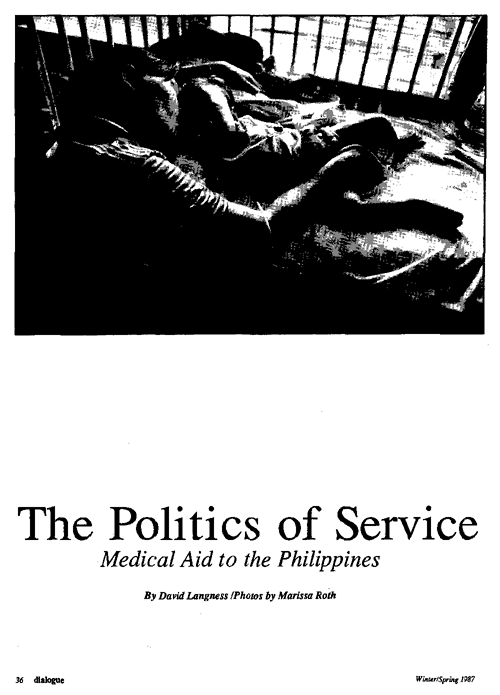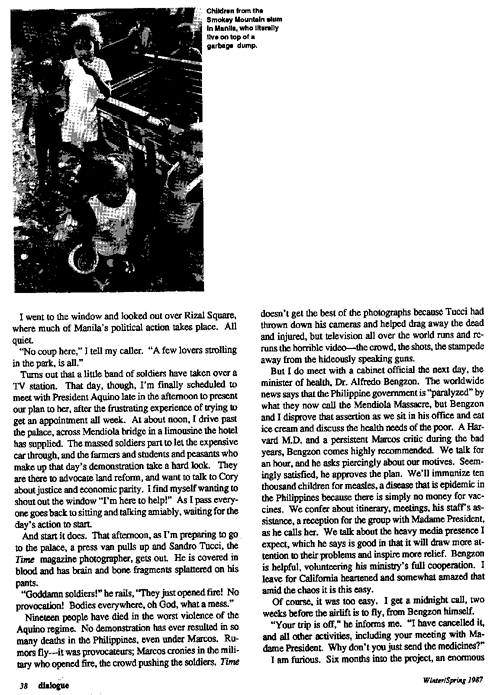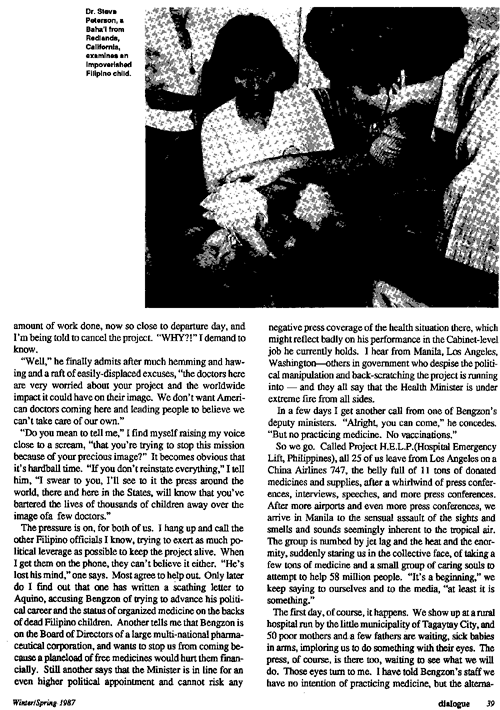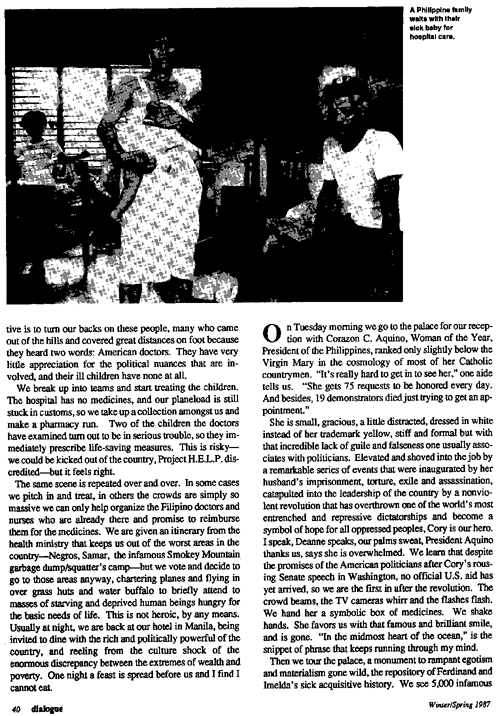
|
|
Abstract: On delivering volunteer hospital services and emergency aid to a corrupted country lacking political stability. Notes: See also list of dialogue articles or image scans. |
The Politics of Service:
Medical Aid to the Philippines
by David Langness
published in dialogue, 1:4, pages 36-41Los Angeles: 1987
When we turn the corner Deanne gasps audibly. She sees the cyst and its unfortunate host, sitting on a hospital bed like all the others on the island of Negros here in the Philippines, jammed into the corner of this dismal institution, built in the ‘20s to hold 300 patients and housing 450 today. Even the group of experienced, inured American doctors and hospital administrators we’ve brought along on this mission of mercy gasp as they round the corner.
The woman perches on a dirty, uncovered mattress wedged into a corner for support. Her dark face holds darting eyes filled to the brim with old pain. Every few moments she expectorates into a coffee can, which cause her labored breathing to strain even more. A massive bulge that has taken over her entire torso swells under a thin dress, from neck to hips, much bigger than any conceivable pregnancy, virtually paralyzing the lower half of the hapless patient. “It weighs over a hundred pounds,” the Filipino doctor explains clinically. “We can’t drain it gradually, like you would be able to do in the States, so we must operate.”
“Does she have any chance?!” asks one of our project’s visiting physicians’, amazed, his eyes glued to the distorted mass. In reply, there is a shrug, and a sad shake of the head. A nearby nurse, basking in the attention paid to her celebrity patient, chimes in, “It’s been growing ten years!” she reports eagerly.
“Why?” Deanne asks intently, her eyes narrowed in disbelief and shock at the suffering, appalled enough for all of us.
“Oh,” the doctor explains as he begins to leads us to more of the hospital, “witchcraft. Faith healers. In the mountains, the people believe in that stuff.”
You wonder, when you walk into a hospital in the Philippines, how conditions could be much worse. When you go through the health care facilities in any country, a simple look at how the poor are treated when they get sick can give you a pretty good clue as to the country’s social priorities. Here, the suffering from 20 years of a despotic rule that left the country virtually bankrupt is readily apparent. Conditions, everywhere we’ve visited, are appalling—no medicines, no sanitation, no resources, all in a tropical country with the disease rates, malnutrition, infant mortality, and insurgency-related trauma indigenous to the worst Third World settings.
But it is here, to the remote parts of the Philippines where medical help is needed most, that Deanne LaRue and I have labored to bring some medical relief for the last six months. We work in the communications department of a large hospital council in Southern California, and because we’re both Bahá'ís, want our jobs to give us the opportunity to serve mankind. To do that, we’ve pulled together an airlift of charity medical supplies and personnel, and flown to Manila to see how we could help Cory Aquino’s new government and the poorest of the poor—the Filipino children.
We’re in the middle of finding out, though, that the enormity of the problems, and the extreme stresses and political complications of mounting a “social and economic development” project have stretched us to the breaking point.
All of its starts with a simple request from a few Filipino women from Los Angeles. “Do you think your hospitals could give us some surplus medicines to take back home to the children in the Philippines? A few grocery bags full? The conditions are very bad, and Cory has asked us to help.”
So we read what’s been written, contact people, do the research. We are stunned. Marcos and his cronies have robbed the country blind, and halt, and lame. Health care is the hardest hit, with the resources that should have been going to solve massive public health problems instead buying Imelda’s shoes and lining the pockets of the privileged for two decades. But now Marcos has fled, thrown out by the people, who had risen up as one in a miraculous nonviolent revolution that has heartened and amazed the whole world. Cory is in, and greatness, hope, love are in the air. How can we help it? We say yes, damn right, we’ll give you some medicines.
So we set it up. Recruit 25 volunteer doctors and hospital administrators, plan and set up a ‘sister hospital’ network that allows hospitals here in the United States to adopt and continuously donate to hospitals in the Philippines, ask California hospitals to donate medicines and supplies and equipment, plead with the airlines to give us a free plane, work out the endless details with consular officials and governments and the media and a whole lot of well-meaning, very sincere, and wonderfully spiritual people who want to help. Some, we find as we go along, are in it for the glory or for some hidden agenda political reason or to curry favor somewhere, but most are there because their hearts dictate some altruistic reason for their efforts. One of them warns me: “You know,” he says quietly one day, “deal with the poor, anywhere, and it is political.”
“Sure, I know,” I assure him. I had no idea.
My first Philippine visit was a scouting trip, but it turned bad early on. It was January, and Cory’s new government, not yet in power a year, was still shaky. There were demonstrations and coup attempts almost every day, from the far right and the far left, and the worldwide media were aggressively reporting on the destabilization attempts this youngest democracy was fighting.
I had just gotten through a week of official meetings in Manila, trotting from one government office to the next, arranging the details of our upcoming airlift, and a call from the States came in early that day.
“Are you alright?” the panicked voice said, halfway around the planet.
“Other than this call and the resultant sleep deprivation,” I said, “why wouldn’t I be?”
“Well, it’s all over the TV here—big coup. Connie Chung just reported it. Tanks, guns, Cory’s in trouble.”
I went to the window and looked out over Rizal Square, where much of Manila’s political action takes place. All quiet.
“No coup here,” I tell my caller. “A few lovers strolling in the park is all.”
Turns out that a little band of soldiers have taken over a TV station. That day, though, I’m finally scheduled to meet with President Aquino late in the afternoon to present our plan to her, after the frustrating experience of trying to get an appointment all week. At about noon, I drive past the palace, across Mendiola bridge in a limousine the hotel has supplied. The massed soldiers part to let the expensive car through, and the farmers and students and peasants who make up that day’s demonstration take a hard look. They are there to advocate land reform, and want to talk to Cory about justice and economic parity. I find myself wanting to shout out the window “I’m here to help!” As I pass everyone goes back to sitting and talking amiably, waiting for the day’s action to start.
And start it does. That afternoon, as I’m preparing to go to the palace, a press van pulls up and Sandro Tucci, the Time magazine photographer, gets out. He is covered in blood and has brain and bone fragments splattered on his pants.
“Goddamn soldiers!” he rails, “They just opened fire! No provocation! Bodies everywhere, oh God, what a mess.”
Nineteen people have died in the worst violence of the Aquino regime. No demonstration has ever resulted in so many deaths in the Philippines, even under Marcos. Rumors fly—it was provocateurs; Marcos cronies in the military who opened fire, the crowd pushing the soldiers. Time doesn’t get the best of the photographs because Tucci had thrown down his cameras and helped drag away the dead and injured, but television all over the world runs and reruns the horrible video—the crowd, the shots, the stampede away from the hideously speaking guns.
But I do meet with a cabinet official the next day, the minister of health, Dr. Alfredo Bengzon. The worldwide news says that the Philippine government is “paralyzed” by what they now call the Mendiola Massacre, but Bengzon and I disprove that assertion as we sit in his office and eat ice cream and discuss the health needs of the poor. A Harvard M.D. and a persistent Marcos critic during the bad years, Bengzon comes highly recommended. We talked for an hour, and he asks piercingly about our motives. Seemingly satisfied, he approves the plan. We’ll immunize ten thousand children for measles, a disease that is epidemic in the Philippines because there is simply no money for vaccines. We confer about itinerary, meetings, his staff’s assistance, a reception for the group with Madame President, as he calls her. We talk about the heavy media presence I expect, which he says is good in that it will draw more attention to their problems and inspire more relief. Bengzon is helpful, volunteering his ministry’s full cooperation. I leave for California heartened and somewhat amazed that amid the chaos it is this easy.
Of course, it was too easy. I got a midnight call, two weeks before the airlift is to fly, from Bengzon himself.
“You trip is off,” he informs me. “I have cancelled it, and all other activities, including your meeting with Madame President. Why don’t you just send the medicines?”
I am furious. Six months into the project, an enormous amount of work done, now so close to departure day, and I’m being told to cancel the project. “WHY?!” I demand to know.
“Well,” he finally admits after much hemming and hawing and a raft of easily-displaced excuses, “the doctors here are very worried about your project and the worldwide impact it could have on their image. We don’t want American doctors coming here and leading people to believe we can’t take care of our own.”
“Do you mean to tell me,” I find myself raising my voice close to a scream, “that you’re trying to stop this mission because of your precious image?” It becomes obvious that it’s hardball time. “If you don’t reinstate everything,” I tell him, “I swear to you, I’ll see to it the press around the world, there and here in the States, will know that you’ve bartered the lives of thousands of children away over the image of a few doctors.”
The pressure is on, for both of us. I hang up and call the other Filipino officials I know, trying to exert as much political leverage as possible to keep the project alive. When I get them on the phone, they can’t believe it either. “He’s lost his mind,” one says. Most agree to help out. Only later do I find out that one has written a scathing letter to Aquino, accusing Bengzon of trying to advance his political career and the status of organized medicine on the backs of dead Filipino children. Another tells me that Bengzon is on the Board of Directors of a large multi-national pharmaceutical corporation, and wants to stop us from coming because a planeload of free medicines would hurt them financially. Still another says that the Minister is in line for an even higher political appointment and cannot risk any negative press coverage of the health situation there, which might reflect badly on his performance in the Cabinet-level job he currently holds. I hear from Manila, Los Angeles, Washington—others in government who despise the political manipulation and back-scratching the project is running into—and they all say that the Health Minister is under extreme fire from all sides.
In a few days I get another call from one of Bengzon’s deputy ministers. “Alright, you can come,” he concedes. “But no practicing medicine. No vaccinations.”
So we go. Called Project H.E.L.P. (Hospital Emergency Lift, Philippines), all 25 of us leave from Los Angeles on a China Airlines 747, the belly full of 11 tons of donated medicines and supplies, after a whirlwind of press conferences, interviews, speeches, and more press conferences. After more airports and even more press conferences, we arrive in Manila to the sensual assault of the sights and smells and sounds seemingly inherent to the tropical air. The group is numbed by jet lag and the heat and the enormity, suddenly staring us in the collective face, of taking a few tons of medicine and a small group of caring souls to attempt to help 58 million people. “It’s a beginning,” we keep saying to ourselves and to the media, “at least it is something.”
The first day, of course, it happens. We show up at a rural hospital run by the little municipality of Tagaytay City, and 50 poor mothers and a few fathers are waiting, sick babies in arms, imploring us to do something with their eyes. The press, of course, is there too, waiting to see what we will do. Those eyes turn to me. I have told Bengzon’s staff we have no intention of practicing medicine, but the alternative is to turn our backs on these people, many who came out of the hills and covered great distances on foot because they heard two words: American doctors. They have very little appreciation for the political nuances that are involved, and their ill children have none at all.
We break up into teams and start treating the children. The hospital has no medicines, and our planeload is still stuck in customs, so we take up a collection amongst us and make a pharmacy run. Two of the children the doctors have examined turn out to be in serious trouble, so they immediately prescribe life-saving measures. This is risky—we could be kicked out of the country, Project H.E.L.P. discredited—but it feels right.
The same scene is repeated over and over. In some cases we pitch in and treat, in others the crowds are simply so massive we can only help organize the Filipino doctors and nurses who are already there and promise to reimburse them for the medicines. We are given an itinerary from the health ministry that keeps us out of the worst areas in the country—Negros, Samar, the infamous Smokey Mountain garbage dump/squatter’s camp—but we vote and decide to go to those areas anyway, chartering planes and flying in over grass huts and water buffalo to briefly attend to masses of starving and deprived human beings hungry for the basic needs of life. This is not heroic, by any means. Usually at night, we are back at our hotel in Manila, being invited to dine with the rich and politically powerful of the country, and reeling from the culture shock of the enormous discrepancy between the extremes of wealth and poverty. One night a feast is spread before us and I find I cannot eat.
On Tuesday morning we go to the palace for our reception with Corazon C. Aquino, Woman of the Year, President of the Philippines, ranked only slightly below the Virgin Mary in the cosmology of most of her Catholic countrymen. “It’s really hard to get in to see her,” one aide tells us. “She gets 75 requests to be honored every day. And besides, 19 demonstrators died just trying to get an appointment.”
She is small, gracious, a little distracted, dressed in white instead of her trademark yellow, stiff and formal but with that incredible lack of guile and falseness one usually associates with politicians. Elevated and shoved into the job by a remarkable series of events that were inaugurated by her husband’s imprisonment, torture, exile and assassination, catapulted into the leadership of the country by a nonviolent revolution that has overthrown one of the world’s most entrenched and repressive dictatorships and become a symbol of hope for all oppressed peoples, Cory is our hero. I speak, Deanne speaks, our palms sweat, President Aquino thanks us, says she is overwhelmed. We learn that despite the promises of the American politicians after Cory’s rousing Senate speech in Washington, no official U.S. aid has yet arrived, so we are the first in after the revolution. The crowd beams, the TV cameras whirr and the flashes flash. We hand her a symbolic box of medicines. We shake hands. She favors us with that famous and brilliant smile, and is gone. “In the midmost heart of the ocean,” is the snippet of phrase that keeps running through my mind.
Then we tour the palace, a monument to rampant egotism and materialism gone wild, the repository of Ferdinand and Imelda’s sick acquisitive history. We see 5,000 infamous shoes (size eight and a half), a bank vault filled to overflowing with jewels, 150 Louis Vuitton purses still in their boxes, dozens upon dozens of ten-gallon decanters of French perfume, fur coats everywhere, weird self-reverential paintings where the Marcos’ faces, strangely devoid of emotion and feeling behind the eyes, have become the faces of saints and mythical figures of courage and beauty. In the entire country, we’re told, there are five kidney dialysis machines—three are in the Marcos’ bedroom. Deanne and I wonder aloud what the Guardian would have said had he been able to see all this. “Let them be swept away,” we agree is the applicable sentiment, “to the limbo of obsolescent and forgotten doctrines.”
Smoky Mountain is a place that is indescribable, but that can be told of. Manila’s garbage heap, it has been rotting at its bottom for who knows how long, and the organic matter that decays underneath produces a vast quantity of methane gas, which is always on fire, tongues of flame leaping out of the trash here and there, smoke and stench covering the area, and thirty thousand people existing on the mountain’s fetid and Dantesque back. We see children everywhere, eking a living from the mountain’s castaways, collecting plastic or bits of metal to sell for food. No sewer system, no water, no social services, this is life at its most unimaginable. All of us rack our brains, and cannot come up with earthly living conditions that could possibly be worse.
The methane gas is extremely damaging to the lungs, so the hospital nearby is filled with its victims. The hospital is also sinking into the landfill, which means the main floor fills every night with seawater and raw sewage. The administrator, a good man, tells us about a malnutrition study he did with the old Ministry of Health, under Marcos. “We found 20 percent third stage childhood malnutrition,” he says, “but we turned in our report to the palace, and the next day Imelda announced the Philippines had only two percent malnutrition.” But the hospital, an incredible wreck when I last saw it one month before, has now been freshly painted, scrubbed, lit, and outfitted with potted plants. “This doesn’t look that bad,” say a few of the project’s now hardened delegates and the media folks who are with us. I am disgusted by these politics and the base manipulation of our purpose here, but am learning it goes with the territory. In spite of the sprucing up, we still see animals in the wards, surgical gloves being washed for re-use and hung out to dry in the smoke of Smokey Mountain, and one poor woman’s cancer surgery being performed in the hall, with a chalk line inscribed around her gurney on the floor that says “Sterile Area, Do Not Cross.”
If I may, some last observations: Life is a right. To be forced to say that one runs the risk of stating the most obvious cliché, but, without life, or the chance at life, no other rights are possible. Thus, tyrants who deprive people of their lives through denial of health care, whether intentional or through neglect, are beneath the most vile contempt the world can heap upon them. On the other hand, everyone who has a stake in a system that enriches some and impoverishes many owns a piece of that tyrant’s bitter, cold heart.
What we got from the Filipinos, especially the children, were stunning smiles and the warmest, sweetest imaginable level of constant affection. And not one begged or held out a hand imploringly. Amazing.
While strolling the palace grounds with a Filipino friend who had been part of the struggle for 15 years, I pointed to a mass of wire cages in one corner and asked about them.
“Marcos’ rare bird collection,” he told me.
“What happened?”
“People ate them.” We laughed for a long time.
No social and economic development program undertaken by Bahá'ís can discount the importance of political impact—if we ignore it, we do so at our own peril and at the peril of those we hope to serve.
And this. Once you walk the soil and look into those faces, in spite of the overwhelming nature of the problems and your relative powerlessness to do anything about them, you are changed.
David Langness is vice president of communications for the Hospital Council of Southern California and also serves as the Executive Director of the National Health Foundation. His most recent project involved working with the humanitarian relief group Medical Aid for El Salvador and their Children’s Project, which air lifted 12 war-wounded Salvadoran children to the U.S. for hospital treatment.
 click for larger image |
 click for larger image |
 click for larger image |
 click for larger image |
 click for larger image |
 click for larger image |
|
|